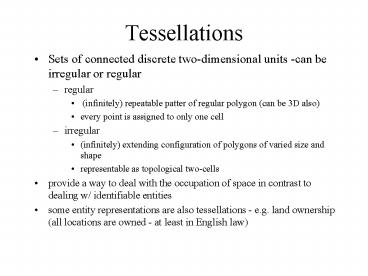Tessellations - PowerPoint PPT Presentation
1 / 12
Title:
Tessellations
Description:
Tessellations. Sets of connected discrete two-dimensional units ... Tessellation/lattice roles. tessellations can be seen as as spatial units for recording data ... – PowerPoint PPT presentation
Number of Views:372
Avg rating:3.0/5.0
Title: Tessellations
1
Tessellations
- Sets of connected discrete two-dimensional units
-can be irregular or regular - regular
- (infinitely) repeatable patter of regular
polygon (can be 3D also) - every point is assigned to only one cell
- irregular
- (infinitely) extending configuration of polygons
of varied size and shape - representable as topological two-cells
- provide a way to deal with the occupation of
space in contrast to dealing w/ identifiable
entities - some entity representations are also
tessellations - e.g. land ownership (all
locations are owned - at least in English law)
2
Tessellations versus entities
Entities - not a full tessellations
B
A
C
regular
D
irregular
3
Irregular tessellations
- phenomenological tessellations (i.e. real ones)
- census units
- generally political/administrative units
- land parcels
- PLSS
- computational irregular tessellations
- Triangulated irregular networks (TINs)
- wire frame models
- many 3D data structures (multiple triangles)
4
Regular tessellations
- all are computational in one sense
- image data form remote sensing
- map grids
- data generated by photogrammetric systems as
lattices of points - regularly sampled data form continuous data
5
Attribute measurement and tesselations
- Tesselations provide a method for the referencing
of entity locations but there is not a one-to-one
relationship to geometric form. Because of the
convenience of referencing, however, regular
tesselations are often seen as real - does value recorded for each two-cell reflect an
average, sum, or ? of the attribute being
observed
6
Lattices
- can be viewed as equivalent to the
intersections of the grid lines in a
tessellation - or can be seen a center of the grid units
- BTW different software does this differently
- lattices are points
- the value at the point can either be seen as the
value there - or as the average of the two-cell that the point
represents - or as a value influenced by other points nearby
7
Tessellation/lattice roles
- tessellations can be seen as as spatial units for
recording data - can also serve as basis for facilitating access
to data distributed continuously in space - use of PLSS for property location
- use of USGS map units (w/ different name) to
organize geographic data - (NOTE - Skipping sections 6.2-6.5)
8
Irregular tessellations based on triangles
- creation of proximal regions
- partitioning of space around centers such that
the boundaries associate the space with the
nearest center - process
- draw lines to connect all centers
- identify mid points of these lines
- connect these to form polygons
- Thiesen polygon, Voroni polygon, Dirichlet domain
9
Triangulation for surface modeling
- triangular irregular models (TIN)
- goals
- facets tend to reflect actual slope
- corners represent important turning points
(ridges, stream valleys etc.) - linear features be represented by triangle edges
- process
- choose data points
- connect points to create triangles
- store necessary data about triangle in DBM system
- avoid long narrow triangles
10
TIN data
- gradient (slope) of each edge
- aspect of each edge
- planar and surface area of each triangle
- slope (gradient) of each triangular facet
- aspect of each triangular facet
11
Preferred triangular structure
- many different triangular tessellations are
possible - commonly preferred is Delaunay triangle
- produces triangles with low variance in edge
length - draw proposed triangle
- draw smallest circle that encompasses triangle
- if circle does not contain any data point then
its accepted - if a data point is contained within the circle
then there is a superior triangle to be drawn
12
Benefits/ problems of triangular tessellations
- benefits
- triangles can be stored/processed as irregular
polygons - they exhaust all space (no holes)
- planar enforcement (no overlaps)
- easy to process in certain software
- problems
- creation computationally demanding
- many different possible triangulations for a
given set of points - can miss critical data characteristics unless
properly formed































